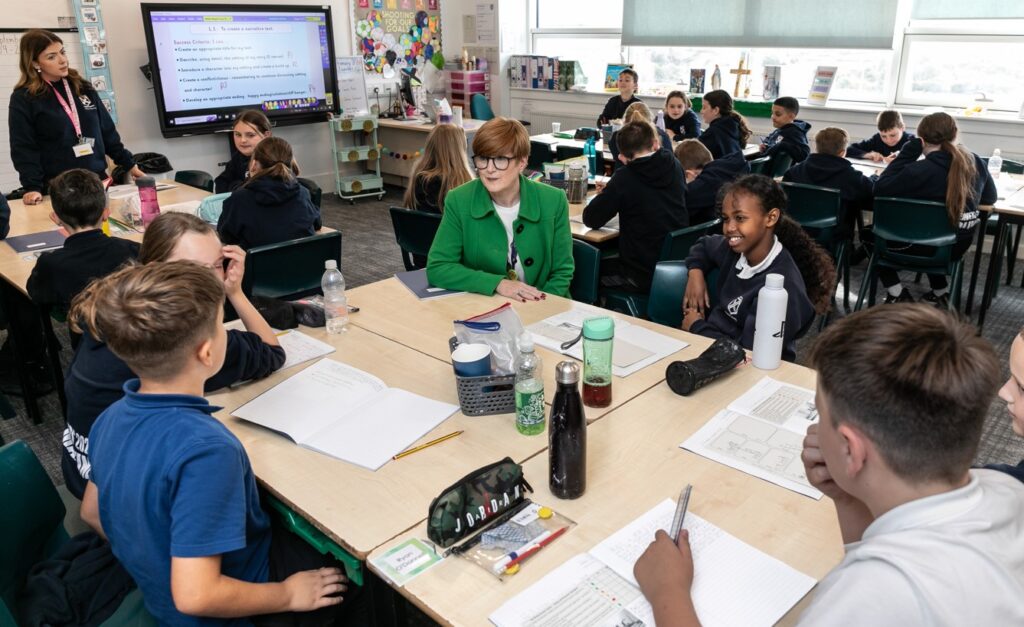
Firstly, can you tell us a little about your teaching and trade union history?
Apart from the first two years of my career when I worked on supply across Strathclyde Regional Council, I’ve worked in the same postcode in the south-west of Inverclyde for almost 30 years. It’s not the same building but it’s the same school community that I serve.
My first permanent post was in St Gabriel’s Primary and they amalgamated with Sacred Heart Primary in 2011 to become St Andrew’s Primary and I’ve worked there since then. I love being in with the bricks, having taught lots of the mums and dads that are now bringing their own wee ones to school. It won’t be long till I hear, ‘Miss, so you taught my gran’…..
My trade union history started in St Gabriel’s as the ‘opener of the union letters’ rather than the rep. It was the school janitor, Eddie MacDonald (GMB), who encouraged me to become the rep.
I didn’t know much about trade-unionism at that point, so I thought that as the rep I had to attend the Inverclyde EIS AGM. So, along I went. I did my polite complaining, presented my solutions and somehow found myself on the Committee of Management. Within a few years I was Vice-President and then President before becoming LA Secretary when my predecessor, Tom Tracey, retired in 2017.
My Committee and LA Secretary roles meant an increasing involvement in the national work of the EIS, attending national AGM, joining Council and serving on Education and Salaries Committees before taking the leap into my national Office-Bearer roles.
You were Vice-President last year, and are now President this year. What does a typical week look like for an EIS Office Bearer?
Typical would be boring, wouldn’t it! There’s no such thing as a typical Office Bearer week but I can take you through the highlights of last week to give you a flavour of what I do.
Buckle up!
I’ve kept on some of my local role so I was dealing with casework for part of the week.
- I’m the elected teacher representative on Inverclyde’s Education and Communities Committee and they met last week and our own Committee of Management met the day after.
- Nationally, EIS was getting ready to attend TUC and as delegation leader I chaired a pre-meeting where the delegation decided on speakers to motions. Because I was speaking on violence and aggression in the workplace, some of my week was spent on research and on writing and rehearsing my speech.
- The EIS meets regularly with various stakeholders across education and last week was no different. Meetings were set up between the Education Department team and the SQA and with the Cabinet Secretary for Education and Skills.
- With SQA we discussed the 2023 post-results service and the lessons learned, alternative assessment arrangements and the workload associated with that for our members, and the return to pre-pandemic coursework and assessment arrangements in 2024 and the workload on members associated with that too.
- EIS representatives met with Jenny Gilruth, the Cabinet Secretary for Education. We set out our concerns around large numbers of teachers without permanent employment, arguing in favour of additional investment in education and the implementation of the Scottish Government’s manifesto commitment to reduce weekly contact hours to 21.0 hours.
Every week is that varied and sometimes the appointments are in the diary well in advance and sometimes there are many diary adjustments to be made to make it all work. There are never two hours the same never mind a typical week!
What do you see as the priorities for the EIS in the year ahead?

To keep on top of all of the priorities has to be a priority!
We’re fortunate in EIS that with our internal structures we can have different departments prioritising different aspects across education and so we can have lots of priorities bubbling away at the same time.
In my diary as I’m writing this, I have EIS-FELA picket lines to visit every morning next week. Their national campaign to have a 2022 pay award that is fully funded and isn’t tied to compulsory redundancies, together with their local campaigns on conditions of service, has to be a priority at the moment, alongside their EIS-ULA colleagues who are re-balloting to extend their strike mandate.
When our FE/HE colleagues win (because they will win) our Stand Up for Quality Education (SU4QE) campaign will be in full swing.
The focus of the SU4QE campaign is on pupil behaviour, workload and ASN resourcing – and it will be a more nuanced campaign than the Pay Attention one, rolling one focus into another into another and back again. Everything in education is interlinked and this campaign will be no different. If the Scottish Government and COSLA truly value education, then they must fund and resource it properly.
Universal Free School Meals – another priority. I am incredibly proud that Inverclyde is the first local authority to provide FSM to all primary pupils from P1 to P7 – it demonstrates that where there’s a will there’s a way and we know that a child who is fed is a child who can better access their learning. But, if one can do it, the other 31 can do it, and once it’s in place from P1 to P7 then we need to go further.
What else? The EIS equality lens is across everything we do; we’ll be submitting a new pay claim at some point this year; we’re still negotiating the reduction in class contact to 21 hours; I’m EIS lead on many ELC working groups and advocate for an increase in Early Years teachers at every turn; precarity of employment for our newly qualified and early career teachers; so many priorities but each of them equally important for us and for the members impacted.
The Stand-Up for Quality Education campaign was launched at the AGM in June – how is the campaign progressing?
It’s early days, but so far so good!
After a soft launch at AGM in June, campaign materials were sent out to schools ahead of the new session and so we’re only really getting in amongst it all now. We’ve started by focussing on Pupil Behaviour and the impact this has on our members.
If the Scottish Government and COSLA truly value education, then they must fund and resource it properly.
Anecdotally, we know that violence and aggression is on the increase in our schools.
Our branch survey will give us the data we need to push local authorities and Scottish Government into actions that protect our members and we’ve extended the submission deadline to give as many branches as possible the opportunity to respond.
This is such an important issue that I moved an EIS motion at TUC Congress 2023 on workplace violence and aggression. The gist of my speech was that work shouldn’t hurt – physically, mentally, emotionally – but when it does, we must report it and we must record it.
The EIS is represented at the Cabinet Secretary’s behaviour summit, and we’ve been clear in that space that violence in school is a health and safety issue. I think there needs to be a shift in mindsets – yes, our classrooms are learning spaces, but they are also workplaces, and we should have the same protections from violence and aggression as any other front- facing public sector worker. We must move away from the idea that reporting and recording is ‘putting our head above the parapet.’
The more accurate the data we have, the more equipped we are to fight for protections. Report, report, report.
You became social-media famous for your colour-matching during previous EIS campaigns…any plans for topping that during the Stand-Up campaign?
My sartorial campaign elegance is incredibly stereotypical of ‘primary teacher does union campaign’ and of course I’ve got plans to match, if not top, that during the SU4QE campaign!
It’s quite liberating having a limited colour-palette to choose from and of course, it helps that I love all campaign merchandise! It’s also amazing to see the different ways members have to style up a t-shirt or tabard! This time round we have coasters to rest our campaign cups on, the ubiquitous campaign pen and car sticker, car air freshener and hopefully some new berets.
Finally, can you tell us one thing about yourself that we might find surprising?
Not sure you’ll find this as surprising as I did – the EIS has uncovered my poetic side!
As part of a STUC Women’s Committee project – Herstory – I’ve taken part in writing workshops aimed at gathering trade union women’s stories and every activity I did ended with something poetic. We were then to work on a piece to submit and they’ll be launched at STUC Women’s Conference at the end of October. I’m not sure I’m allowed to tell you much more for now, but I’ve submitted a poem called ‘Work-Life-Balance’ that I’m very proud of.
